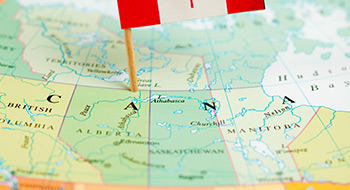

Currency, more than commodities, may ultimately determine if the Canadian economy gets its groove back, according to a Russell Investments study.
“We believe that currency will play a pivotal role in the prospects of the Canadian economy over the next decade,” says Shailesh Kshatriya, director, Canadian strategies at Russell Investments Canada. “Our view is that the Canadian dollar needs to remain low for longer in order to regain competitiveness against the U.S. And more importantly, relative to an increasing imposing manufacturing capacity in Mexico, the loonie needs to be more attractively priced for multinational firms.”
Read: Global growth to pick up in 2015 and 2016: Expert
The report notes the strength of commodity markets in the early 2000s—the oil market in particular—was a boon that came at the cost of lost competitiveness. The negative impact of this was most acute for domestic manufacturers, who saw a strengthening Canadian dollar contributing to a 30% increase in labour costs, while they have remained roughly flat in the U.S.
According to the report, regaining lost manufacturing capacity will not happen overnight. A pre-requisite for bringing greater balance to the domestic economy and tilting reliance away from resources requires the visibility of a weaker Canadian dollar relative to the U.S. dollar for an extended period. “For this reason, we believe the Bank of Canada will be diligent with interest rate moves going forward,” adds Kshatriya.
Russell Investments’ strategists also believe the BoC’s base case of 1.9% 2015 GDP growth is potentially as good as it can get, and have downgraded their growth prospects for the Canadian economy between 1.5% and 1.9% (previously 1.8% and 2.1%).
Read: 7 forecasts for 2015
Global outlook overview
Timing of the initial interest rate increase by the U.S. Federal Reserve and negotiations around the Greek bailout will play key roles in the global outlook. The strategists expect the first rate hike in September—a long-held view— and for Greece to stay in the Eurozone, but acknowledge that uncertainty around these events could lead to market volatility, which they see as an opportunity to add selected risk exposure to portfolios.
To analyze the anticipated Fed rate hike, the strategists compare market conditions before the two previous hikes in February 1994 and June 2004 to current conditions. The standout feature, according to the report, is that equities, bonds and the U.S. dollar are all relatively expensive now compared to the last two tightening phases, and the corporate profit cycle is far more advanced. However, since the upcoming rate hike in their view is one of the best communicated policy shifts on record, they believe the shift is already priced into the markets. After looking at these factors collectively, the team maintains their favoured U.S. market scenario of moderate inflation, moderate jobs growth, and single-digit profit gains.
Read: Expect BoC rate cut, loonie to continue drop: CIBC
“It makes sense to expect volatility around the Fed policy shift, but a key question is whether any resulting market setback would represent a turning point or an inflection point,” says Russell Investments’ global head of investment strategy, Andrew Pease. “We believe an inflection point seems more likely, and for equity markets to remain supported over the medium term if the U.S. economy continues to post moderate growth.”
This story originally appeared on our sister site, Advisor.ca.
